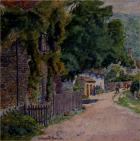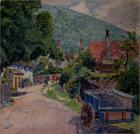signed " A Vincent. Reade." and further inscribed on the reverse " Bossington"
Bossington, a hamlet 1 m. from Porlock, lying under Bossington Beacon, which is the W. end of the North Hill (see Minehead). It is a picturesque place, noteworthy for its huge walnut trees. It is separated from the sea by a stretch of shingle. There is a little chapel of some antiquity, which has a good E. window (restored). The summit of the Beacon may be reached either from the hamlet itself or from Allerford (whence numerous zigzag paths lead through the woods).
Bossington is a picturesque hamlet in Selworthy parish, on the National Trust's Holnicote Estate. Distinctive cottages with chimney stacks and bread ovens bulging from the facades line the single street. There are good walks along the Coast Path to Hurlstone Point and Porlock Marsh and superb views from Bossington Hill. There is a car park, toilets, picnic area and tea gardens in season, and a wildlife park and medieval chapel at nearby Lynch.
Bossington, a long, picturesque thatched village with tea rooms, some fine walnut trees and the starting point for several bracing walks out to Hurlstone Head. Bossington village is part of the National Trust's Holmcote Estate covering 20 square miles, with a rich and varied landscape of rugged coastline, rare ancient woods, heather moorland and a rich heritage of buildings.
The Village:- mainly owned by the Trust, has many interesting cottages in the local style, some with round chimneys and bread ovens. All the cottages and form buildings are maintained by the Estate's building team, using traditional materials, including limewash on cottage walls.
Horner Water:- runs down through the village, emerging into the sea by filtering through the shingle. Once or twice a year, during periods of high rainfall, the river punches a hole through the ridge with a tremendous roar. Many Brown Trout live in the river, attracting the keen interest of Herons.
Archaeology:- at the rear of Bossington Beach a group of ruined buildings form the remains of at least one lime kiln. lime was traditionally brought in by boat and heated in the kiln to render it usable for addition to the acidic soils of Exmoor, to improve them for farming. A number of pillboxes dating from World War II can be seen, built to defend the coastline against invasion. Coastal Management:- the shingle ridge protecting the low-lying farmland has recently been breached by high tides, evidence suggests that in the past the area behind the ridge was tidal rather than freshwater, as it is today. As the ridge is likely to be breached by the sea again, the National Trust is developing a management strategy which takes advantage of frequent inundation by the sea. This allows the valuable salt marsh to increase and improves the habitat for birds.
Bossington Hill:- a walk from the car park takes you over the river and around the foot of Bossington Hill towards Hurlstone Point. The ruined coastguard station at the tip of the Point offers splendid views around the bay. A return walk leads back around a higher contour of the hill. The view looking down on to the villages of the Vale is magnificent.
Bossington Beach: this shingle ridge stretches from Hurlstone Point round Porlock Bay to Porlock Weir. The steeply shelving beach is open to the Atlantic gales and the waves grade the pebbles up the beach according to size, the smallest being at the crest of the beach. At low water, rock pools are visible, havens for crabs, sea anemones and numerous "Shellfish. Birds such as Curlew, Oystercatohers, Shelduck and Gulls are attracted by these rich pickings.
Selworthy is a small village and civil parish 5 kilometres (3 mi) from Minehead in Somerset, England. It is located in the National Trust's Holnicote Estate on the northern fringes of Exmoor. The parish includes the hamlets of Bossington, Tivington, Lynch, Brandish Street and Allerford.
At 308 metres (1,010 ft) Selworthy Beacon, rising above the village, is one of the highest points on Exmoor. Its height defines as one of the 'marilyns" in England. Near the summit are a series of cairns, thought to be the remains of round barrows, and the British Iron Age Bury Castle.
Bossington is separated from Porlock Bay by a shingle beach, through which flows the River Horner, forming part of the Porlock Ridge and Saltmarsh Site of Special Scientific Interest. In the 1990s rising sea levels created salt marshes, and lagoons developed in the area behind the boulder bank. The village is on the South West Coast Path. The name of the village means "enclosure or settlement near sallows or willows". In the Domesday Book it was recorded as Selewrda. It was held by Queen Edith of Wessex in 1066 and, with Luccombe, was awarded to Ralph de Limesy by William the Conqueror. In 1301 Edward I awarded it to Henry de Pynkeny.[6] It passed down through the family until acquired by marriage by Sir Thomas Dyke Acland in 1802.
Selworthy was part of the hundred of Carhampton.
Selworthy was rebuilt as a model village, to provide housing for the aged and infirm of the Holnicote estate, in 1828 by Sir Thomas Acland,[9] in a similar style to Blaise Hamlet, Bristol, which had been built a few years earlier. One of the cottages, known as Periwinkle Cottage, is now an award-winning tea room.[10] Many of the other cottages, whose walls are painted with limewash that has been tinted creamy yellow with ochre, some of which are now rented out, are still thatched and are listed buildings. The village and the surrounding Holnicote estate was given to the National Trust in 1944 by Sir Richard Acland, having been passed down through the Acland family for nearly 200 years.
Few of the buildings preceding 1828 survive, but those that do include the church, the tithe barn and Tithe Barn Cottage.
Albert Vincent Reade was born in 1864, he was a portrait, landscape and still life painter. He studied at the Manchester Academy of Fine Arts and Colarossi's Paris, He exhibited between 1901 and 1933 and lived in Manchester.



